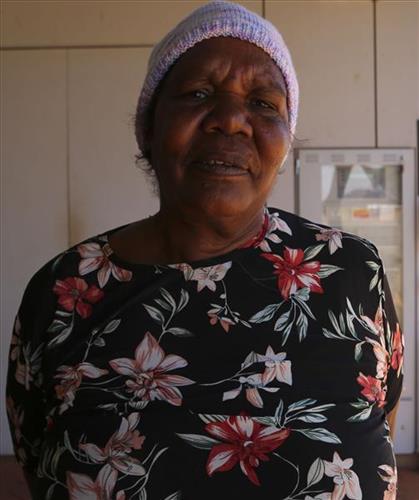111582333156
Flowers blooming on the Canning
“This is the wells along the Canning Stock Route. I’m from Well number 1, that’s where Wiluna is. From Well number 5 through to 15, that is where we had our determination, the Birriliburu [Native Title] determination. The government gave us our land back, so that’s why I’m painting my Country there, to make me proud. We are proud to get our land back, happy.
When it’s spring that’s when the wildflowers come out on the Canning (stock route). When you go travelling you see flowers everywhere. You see the purple and green mulla mulla, red marlukururrpa (sturt desert pea), and the pink and white desert rose, yellow belly buttons, and blue belly buttons.
I painted the claypans, dried claypans all around, and the waterholes that were turned to wells along the Canning Stock Route. When our ancestors were roaming they knew where to find the water underground when the other water is dry.
We go back on Country and they [the elders] show us where they been walking around. When the waterholes have been destroyed by camels and cattle we clean it up- that’s our job to clean it and look after our Country. Without us it’ll die on us. We need to care for our Country and show the young generation to take over.”
– Roxanne Anderson
In this work, Roxanne has depicted several themes relating to her ngurra (home Country), including the historically significant Canning Stock Route, the seasonal blooming of wildflowers, and the significance and care for water sources.
Western Australia’s gold rush, beginning in 1885, created a huge demand for beef from mines located between Halls Creek and Wiluna, which led to the construction of the near 2000 kilometre Canning Stock Route. The construction of the route by Alfred Canning and his team in 1910 resulted in first contact with Europeans for many Martu then living a pujiman (traditional, desert dwelling) life in the desert. This contact began with Canning’s use of Aboriginal guides to lead him to the sources of water that would be transformed into 48 stock route wells. Acts of cruelty toward these guides included, amongst other things, chaining them at night to prevent their escape and giving them salt water to drink, thereby ensuring their thirst and subsequent necessity to lead the party to water sources.
Following the construction of the Canning Stock Route, Martu encountered Europeans and other Martu working as cattle drovers as they would travel up and down the Stock Route from water source to water source. Increasingly, pujiman followed the route to newly established ration depots, mission and pastoral stations. By the late 1950s and early 1960s, most of the desert family groups had left the desert.
Patterns of movement which had defined Aboriginal people’s relationships to Country were forever changed by the Canning Stock Route, but the Martu relationship with Country remains strong through the maintenance of physical and cultural ties to desert life and knowledge.
During the pujiman (traditional, desert dwelling) period, knowledge of water sources was critical for survival, and today Martu Country is still defined in terms of the location and type of water. Waterholes are sites that require maintenance, including digging to increase flow, clearing out surrounding growth, and cleaning up after sullying by camels or cattle.
Also depicted in this work are the remarkably diverse flora found through Martu Country. These plants are not only vital as significant food sources, but also celebrated for their aesthetic splendour. In the context of the often harsh and arid environments in which desert flowers bloom, their vibrancy, delicacy, and variation become even more spectacular.




